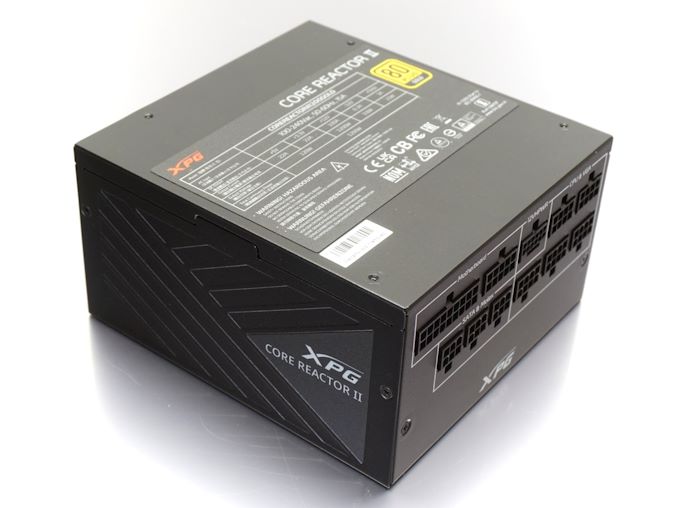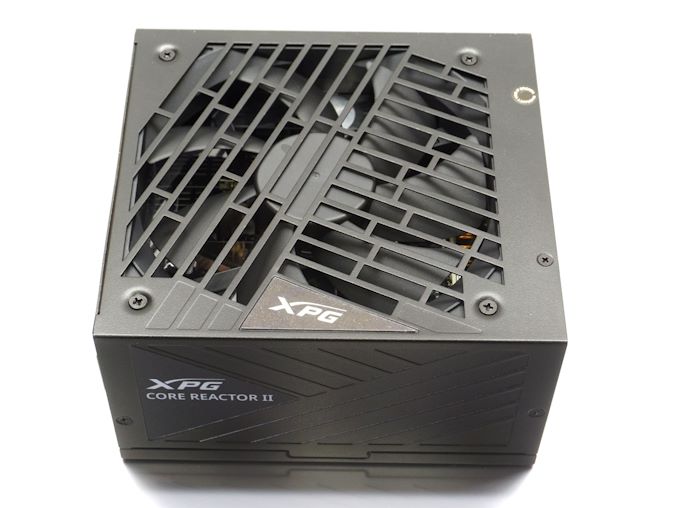The XPG Core Reactor II 1200W PSU Review: XPG Goes for the Gold
by E. Fylladitakis on December 19, 2023 8:00 AM EST- Posted in
- Cases/Cooling/PSUs
- PSUs
- 1200W
- 80Plus Gold
- XPG
- ATX v3.0
- 12VHPWR
Power Supply Quality
As part of our testing, we also check output parameters are within specifications, as well as voltage ripple and line noise.
| Main Output | ||||||||
| Load (Watts) | 241.78 W | 603.33 W | 902.84 W | 1200.7 W | ||||
| Load (Percent) | 20.15% | 50.28% | 75.24% | 100.06% | ||||
| Amperes | Volts | Amperes | Volts | Amperes | Volts | Amperes | Volts | |
| 3.3 V | 2.04 | 3.36 | 5.11 | 3.35 | 7.67 | 3.34 | 10.22 | 3.33 |
| 5 V | 2.04 | 5.08 | 5.11 | 5.07 | 7.67 | 5.05 | 10.22 | 5.04 |
| 12 V | 18.59 | 12.08 | 46.46 | 12.06 | 69.7 | 12.03 | 92.93 | 12 |
| Line | Regulation (20% to 100% load) |
Voltage Ripple (mV) | |||||
| 20% Load | 50% Load | 75% Load | 100% Load | CL1 12V |
CL2 3.3V + 5V |
||
| 3.3V | 0.8% | 8 | 10 | 12 | 14 | 12 | 14 |
| 5V | 0.8% | 8 | 12 | 12 | 16 | 12 | 14 |
| 12V | 0.65% | 20 | 16 | 18 | 30 | 30 | 18 |
The electrical performance of the XPG Core Reactor II 1200W PSU is notable, particularly for its focus on the primary 12V rail. This rail exhibits impressive regulation, maintaining a variance of only 0.7% across its nominal load range. Additionally, the PSU demonstrates effective voltage filtering, with a maximum voltage ripple of 30 mV on the 12V rail. The performance on the 3.3V and 5V rails is also commendable, showing voltage regulation of around 0.8% and maximum voltage ripples of 14 mV and 16 mV respectively. These figures are far better than design recommendations and are considered very good even for a performance product, indicating a well-engineered power supply.
In terms of primary protections, the XPG Core Reactor II has been thoroughly tested for Over Current, Over Voltage, Over Power, and Short Circuit protections. The results indicate reliable performance in these areas. Specifically, the Over Current Protection (OCP) on the 12V rail is effectively activated at 121% of the unit's maximum capacity. The Over Power Protection (OPP) also engages appropriately, triggering at 121% under high load conditions, providing a robust safety mechanism for the PSU.
Conclusion
The XPG Core Reactor II 1200W PSU stands out as a strong contender in the high-wattage power supply segment. It boasts a robust build quality and unique aesthetics, with a matte black exterior and geometric embossed patterns that add a subtle decorative touch without compromising its functional focus. The unit's internal design is efficiently organized, reflecting XPG's commitment to quality and performance in the PSU market. The use of high-grade Japanese capacitors, including Nippon Chemi-Con and a few Rubycon capacitors, underscores the PSU's reliability and durability.
In terms of power quality, the Core Reactor II excels with very good voltage regulation and effective filtering on every voltage rail. It achieves good energy conversion efficiency, with an average efficiency of 89.9% at 115 VAC and 91.3% at 230 VAC during cold testing, marking it as a competitive unit in its class. The efficiency remains steady across most of the load range, with the design’s weakest efficiency point being loads under 15% capacity.
Thermally, the Core Reactor II manages heat fairly effectively considering its power output and efficiency. The internal temperatures remain reasonable under various load conditions with the unit operating at or near room temperature. The fan, operating from 40% capacity, adjusts its speed according to the load, ensuring efficient cooling. The PSU's noise levels are minimal at lower loads, increasing only under heavy usage, making it suitable for environments where noise is a concern. The PSU will only get overly hot if heavily loaded inside a very warm operating environment, reaching temperatures that will provoke the OTP to kick in.
Priced at $185, the Core Reactor II offers good value, especially considering its all-around performance and the inclusion of a 10-year warranty. This positions it as an appealing option for users seeking a balance between cost, efficiency, and reliability. The Core Reactor II 1200W PSU, with its quality components, solid efficiency, and reliable thermal management, is a commendable choice for those in need of a robust and efficient power supply, offering a blend of performance and value that should be considered.












9 Comments
View All Comments
PeachNCream - Tuesday, December 19, 2023 - link
They know their audience if they're including girl-in-spandex stickers.Threska - Tuesday, December 19, 2023 - link
Seems the majority have already licked the most important "bells and whistles" and that's it working like a competent PSU within it's ranges. Bells and whistles would be RGB lighting or USB monitoring.blppt - Wednesday, December 20, 2023 - link
The RTX5090 probably will require an actual reactor the way things are going.tipoo - Wednesday, December 20, 2023 - link
Is there an in depth Meteor Lake review coming?Ryan Smith - Wednesday, December 20, 2023 - link
Yes. Though don't expect anything until after the holiday period.sonny73n - Wednesday, December 20, 2023 - link
PSU cables are still as stiff as ever and no new design innovation.Threska - Wednesday, December 20, 2023 - link
With modular PSU cables should be easier to replace with something silicone. Only thing fixed is the ATX cable.timecop1818 - Friday, December 22, 2023 - link
fixed how? every recent modular PSU I've seen the 24atx part is also modular, removable.meacupla - Saturday, December 23, 2023 - link
Softer cables tend to use less copper and less copper is not a desirable feature for ATX PSU cables.You really don't want to go less than 18AWG. Some higher quality PSUs use 17 or 16AWG for EPS/PCIe.
If you want to go fully custom, be my guest and use 20 or 22 AWG.